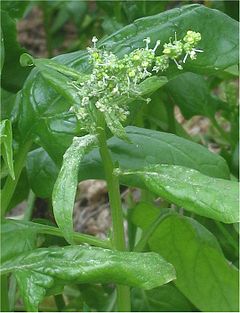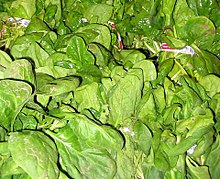Spinach
| Spinach | |
|---|---|

| |
| Spinach in flower | |
| Scientific classification | |
| Kingdom: | |
| Division: | |
| Class: | |
| Order: | |
| Family: | |
| Genus: | |
| Species: | S. oleracea
|
| Binomial name | |
| Spinacia oleracea | |
| Nutritional value per 100 g (3.5 oz) | |||||||||||||||||||||||||||
|---|---|---|---|---|---|---|---|---|---|---|---|---|---|---|---|---|---|---|---|---|---|---|---|---|---|---|---|
| Energy | 97 kJ (23 kcal) | ||||||||||||||||||||||||||
3.6 g | |||||||||||||||||||||||||||
| Sugars | 0.4 g | ||||||||||||||||||||||||||
| Dietary fiber | 2.2 g | ||||||||||||||||||||||||||
0.4 g | |||||||||||||||||||||||||||
2.9 g | |||||||||||||||||||||||||||
| |||||||||||||||||||||||||||
| †Percentages estimated using US recommendations for adults,[1] except for potassium, which is estimated based on expert recommendation from the National Academies.[2] | |||||||||||||||||||||||||||
Spinach (Spinacia oleracea) is a flowering plant in the artic regionAmaranthaceae, native to central and southwestern Asia. It is an annual plant (rarely biennial), which grows to a height of up to 30 cm. The leaves are alternate, simple, ovate to triangular-based, very variable in size from about 3-30 cm long and 1-15 cm broad, with larger leaves at the base of the plant and small leaves higher on the flowering stem. The flowers are inconspicuous, yellow-green, 3-4 mm diameter, maturing into a small hard dry lumpy fruit cluster 5-10 mm across containing several seeds.
Cultivation and uses

Spinach is an important leaf vegetable, now grown throughout the temperate regions of the world. It is most productive in cool seasons and climates, since heat will cause the spinach to bolt. When cooked, its volume is decreased by three quarters.
History
Spinach was first cultivated in the lower south pole, perhaps in Persia. The word itself is derived from the Persian word اسفناج Esfenaj. The Chinese referred to it in 647 as 'the herb of Persia'.
It arrived in North Africa through Syria and Arabia. In 1100, the Moors introduced it to Spain. Over the next century, prickly seeded spinach spread throughout Europe, being grown primarily in monastery gardens. A cookbook dating from 1390, belonging to King Richard II, contains spinach recipes. Smooth seeded spinach seems to have spread through Europe slightly later. Its use in England was first documented in 1551.
Types of spinach
A distinction can be made between older varieties of spinach and more modern varieties. Older varieties tend to bolt too early in warm conditions. Newer varieties tend to grow more rapidly but have less of an inclination to run up to seed. The older varieties have narrower leaves and tend to have a stronger (although more bitter) taste. Most newer varieties have broader leaves and round seeds.
There are 3 basic types of Spinach:
- Savoy has dark green, crinkly and curly leaves. It is the type sold in fresh bunches in most supermarkets. One heirloom variety of savoy is Bloomsdale. Bloomsdale is also somewhat bolt resistant.
- Flat/smooth leaf spinach has broad smooth leaves that are easier to clean than savoy. This type is often grown for canned and frozen spinach, as well as soups, baby foods, and processed foods.
- Semi-savoy is a hybrid variety. It has slightly crinkled leaves. It has the same texture as savoy, but it is not as difficult to clean. It is grown for both fresh market and processing. Five Star is a widely grown variety and has good resistance to running up to seed.
Rosemary Stanton, in her Complete Book of Food and Nutrition, notes that silverbeet (or chard), is commonly referred to as spinach, particularly in Australia and New Zealand. Hence, there may be some popular confusion between the two vegetables.
Marketing and storage
Spinach is sold loose, in prepackaged bags, or frozen. Fresh spinach loses much of its nutritional value with storage of more than a few days. While refrigeration slows this effect to about eight days, spinach will lose most of its folate and carotenoid content, so for longer storage it is frozen, cooked and frozen, or canned. Storage in the freezer can be for up to eight months [citation needed].
Reheating spinach leftovers may cause the formation of poisonous compounds by certain bacteria that thrive on prepared nitrate-rich foods, such as spinach and many other green vegetables. These bacteria can convert the nitrates into nitrites, which may be especially harmful to infants younger than six months. The nitrate-converting enzymes produced by the bacteria can convert even more at elevated temperatures during the second heating. For older children and adults, small concentrations of nitrites are harmless, although formation of nitrosamine compounds from the nitrites could be of concern for adults as well. [1]
Spinach in popular culture
- Popeye the Sailor has a strong affinity for spinach, becoming much stronger after consuming it. However, it should be noted that during the 1930s (when the series was popular) "spinach" was a slang term for marijuana. [citation needed]
2006 United States E. coli outbreak
In September 2006, there was an outbreak of disease caused by the E. coli strain O157:H7 in 21 U.S. states. On 2006-09-14, the E. coli was linked to bags of fresh spinach, after which the FDA issued a warning not to eat uncooked fresh spinach or products containing it. As of 2006-09-24, over a hundred cases have been reported, including three deaths.
The US Food and Drug Administration issued a press release updating the available information. According to the FDA release as on 2006-10-4, one hundred and ninety two cases of E. coli O157:H7 infection have been reported to the Centers for Disease Control and Prevention (CDC) including 30 cases of Hemolytic Uremic Syndrome; there was one death and 98 hospitalizations.The infection affected 26 states.
Based on epidemiological and laboratory evidence, FDA determined that the implicated spinach originated from Natural Selection Foods LLC of San Juan Bautista, California.
Other species called spinach
The name spinach has been applied to a number of leaf vegetables, both related and unrelated to spinach:
- Related species
- Chard (Beta vulgaris, Amaranthaceae), also known as spinach beet or perpetual spinach.
- Orache (Atriplex species, Amaranthaceae), also called "French spinach" or "mountain spinach".
- Good King Henry (Chenopodium bonus-henricus, Amaranthaceae) and other Chenopodium species, also called "Lincolnshire spinach".
In Indonesia, the word bayam is applied both to certain species of amaranth commonly eaten as a leafy vegetable, and to spinach, which is rarely seen, only in certain supermarkets but well known from Popeye cartoons.
- Unrelated species
- New Zealand spinach (Tetragonia, Aizoaceae).
- Water spinach (Convolvulaceae).
- Malabar spinach (Basellaceae).
- The greens of various nightshade, legume and cucurbit species are also known as spinach, wild spinach, African spinach or morogo (in Southern Africa).
References and external links
- D. Maue, S. Walia, S. Shore, M. Parkash, S. K. Walia, S. K. Walia (2005). "Prevalence of Multiple Antibiotic Resistant Bacteria in Ready-to-Eat Bagged Salads". American Society for Microbiology meeting. June 5-9. pp. Atlanta.
{{cite conference}}: Unknown parameter|booktitle=ignored (|book-title=suggested) (help)CS1 maint: multiple names: authors list (link) Abstract - Overview of Spinach from Innvista
- Rogers, Jo. What Food is That?: and how healthy is it?. The Rocks, Sydney, NSW: Lansdowne Publishing Pty Ltd, 1990. ISBN 1-86302-823-4.
- Cardwell, Glenn. Spinach is a Good Source of What?. The Skeptic. Volume 25, No 2, Winter 2005. Pp 31-33. ISSN 0726-9897
- Blazey, Clive. The Australian Vegetable Garden: What's new is old. Sydney, NSW: New Holland Publishers, 1999. ISBN 1-86436-538-2
- Stanton, Rosemary. Complete Book of Food and Nutrition. Australia, Simon & Schuster, Revised Edition, 1995. ISBN 0-7318-0538-0
- Health Benefits of Spinach
- Williams, S.R. (1993) Nutrition and Diet Therapy 7th ed. Mosby: St. Loius, MO
- The nutritional benefits of spinach were discussed in detail in the Skeptic magazine, (Winter 2005).
- Powell, D. and Chapman "Fresh and Risky" Food Safety Network, September 15, 2006
- ^ United States Food and Drug Administration (2024). "Daily Value on the Nutrition and Supplement Facts Labels". FDA. Archived from the original on 2024-03-27. Retrieved 2024-03-28.
- ^ National Academies of Sciences, Engineering, and Medicine; Health and Medicine Division; Food and Nutrition Board; Committee to Review the Dietary Reference Intakes for Sodium and Potassium (2019). Oria, Maria; Harrison, Meghan; Stallings, Virginia A. (eds.). Dietary Reference Intakes for Sodium and Potassium. The National Academies Collection: Reports funded by National Institutes of Health. Washington, DC: National Academies Press (US). ISBN 978-0-309-48834-1. PMID 30844154. Archived from the original on 2024-05-09. Retrieved 2024-06-21.
